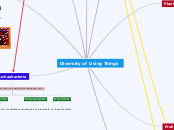Diversity of Living Things
Archaebacteria
similar to bacteria, cell wall without peptodyglocan
Psychrophiles
cold environments
Thermoacidophiles
extreme salt environments
Halophiles
thrive in high salt concentrations
Methanogens
no oxygen environments
Eubacteria
rigid cell walls wot peptidyglocan and flagella for movement
Spiral
Spirillum
has a twisted shape
Spherical
Streptococcus
remains in chains after dividing
Rod shaped
E. Coli
found in lower intestine of warm blooded
organisms
Prokaryotes
small, simple, commonly know as bacteria
Unicellular
Animals
pollinators help spread seeds
Mollusca
Foot for movement, bigger organs and mantle for protection (Shell)
snail
Echinoderms
Radial symmetry and nerves extend everywhere (they don't have a real head and body is made up of tightly interweaved muscles)
star fish
Arthopoda
Have joint limbs unlike Echino. and other phylums + internal airways
Spider
Hexapoda
insects or incecta
Crustacea
branchipoda
Myriapoda
symphyla
pauropoda
diplopoda
millipede
chilopoda
centipede
Chelicerata
Chordata
Subphyla =
Vertebrata
Superclass =
Tetrapods
Mammilia
Mammary glands – produce milk for young -Body hair ( = insulation, camoflague, waterproofing, defense)
-Endothermic, four-chambered hearts, highly developed brains
-Specialized teeth
lion
Amphibia
-Gas exchange across moist
skin
-External fertilization in water
-Adults live on land, but require moist environment
frog
Urochordata
Cephalochordata
Monkey
Mammals
monotremes
lay eggs
monotremata
platypus
marsupials
live birth
Diprotodontia
kangaroo
placentals
born from mothers uterus attached to placenta
Magnorder Xenarthra
sloths
Nematoda
roundworms and 2 openings in digestive system compared to 1 in Platy.
pin worms
Platyhelminthes
simplest organism in which organs occur
-MILESTONE: can also reproduce asexually
tape worm
Cnidaria
they develop nerves and sting/paralyze prey rather than using
jelly fish
developed stinging tentacles
Porifera
sea sponge
Protista
cell wall, uni or multicellular
Feeding strategies
Decompose
Decayed matter
Fungus like
Water moulds
Peronosporales
Slime moulds
Protostelids
Photosynthesis
Sunlight
Plant like
Dinoflagellates
Dinophyceae
Diatoms
Pennate
Green Algea
Marino
Brown Algae
Kelp
Heterotrophs
Feed on other organisms
Animal like
Ciliates
Paramecia
Cilia help swim and capture food
Flagellates
sperms
Flagella-tail like
Sarcodines
Amoeba
Pseudopods
Sporozoans
Glardia
no movement
Plants
Eukaryotes
bigger and more complicated
Multicellular
Fungi
Multicellular, heterotrph
Basidiomycota
Jelly fungi
clublike-mass of hyphae to absorb water,Cap-produce spores
Ascomycota
Mildews,yeast
Saclike structures (ascus), prodce two kind of spores(conidia)
Zygomycota
Black Bread Mold
Black spots(sporangia), release spores
Chytridiomycota
Algea
Large pores, produce flagellated spores









